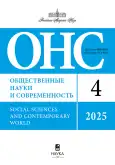Gender reassignment: risks for social and legal identity
- Authors: Dushakova L.A.1, Zubareva O.G.1
-
Affiliations:
- South Russian Institute of Management – branch of the Russian Academy of National Economy and Public Administration under the President of the Russian Federation
- Issue: No 4 (2025)
- Pages: 136-148
- Section: ISSUES OF LAW
- URL: https://journal-vniispk.ru/0869-0499/article/view/323113
- DOI: https://doi.org/10.31857/S0869049925040101
- ID: 323113
Cite item
Abstract
Promotion of the national system of values provides for political and legal justification of non-recognition of arbitrary gender reassignment. Russian legislation establishes an uncontested ban on it, providing for a limited number of exemptions from the general rule. But even within the proposed regulatory model, a whole range of issues requiring regulatory resolution remains relevant, first of all, from the point of view of harmonization of private and public interests. On the one hand, the legislative decision limits the legal exercising of the constitutional right for health protection and taking advantage of medical care in the event of diagnosis of transsexualism as an independent mental disorder requiring medical correction, and may lead to actual exclusion from the socio-legal space of people suffering from such pathology. On the other hand, the emphasis should be made on raising the younger generation and countering promotion of gender diversity and unreasonable (beyond medical indications) gender reassignment, that can be viewed as breaching the right for privacy under the liberal agenda. In this regard, legislation in the field under study should take into account the principle of personal identity, which, from the legal point of view, means, firstly, a differentiated approach to those suffering from mental disorder and those broadcasting non-pathological manifestations of gender perception disorder, and, secondly, elaborating legislation aimed at combating destructive cultural impulses that undermine the state educational policy.
About the authors
L. A. Dushakova
South Russian Institute of Management – branch of the Russian Academy of National Economy and Public Administration under the President of the Russian Federation
Author for correspondence.
Email: dushakova-la@ranepa.ru
Rostov-on-Don, Russia
O. G. Zubareva
South Russian Institute of Management – branch of the Russian Academy of National Economy and Public Administration under the President of the Russian Federation
Email: zubareva-og@ranepa.ru
Rostov-on-Don, Russia
References
- Введенский Г.Е., Матевосян С.Н. (2017) Сексуальные расстройства в проекте МКБ-11: методологические и клинические проблемы // Социальная и клиническая психиатрия. Т. 27. № 3. С. 102–105.
- Vvedenskij G., Matevosyan S. (2017) Sexual disorders in draft ICD-11: methodological and clinical challenges`. Social and clinical psychiatry. vol. 27, no. 3, pp. 102–105 (In Russ.).
- Дробязко С.Р. (2023) Образ жизни личности как предмет конституционно-правовой защиты на примере вопроса о смене пола // Конституционное и муниципальное право. № 1. С. 53–57. https://doi.org/10.18572/1812-3767-2023-1-53-57
- Drobyazko S. (2023) The Way of Life of an Individual as a Subject of Constitutional and Legal Protection on the Example of the Gender Reassignment Issue. Constitutional and Municipal Law. no. 1, pp. 53–57. https://doi.org/10.18572/1812-3767-2023-1-53-57 (In Russ.)
- Кочарян Г.С. (2019) Транссексуальность: диагностические подходы и клиническое наблюдение // Здоровье мужчины. № 1(68). С. 80–85.
- Kocharyan G. (2019) Transsexuality: diagnostic approaches and clinical observation. Men`s Health. no. 1(68), pp. 80–85. (In Russ.)
- Малеина М.Н. (2002) Изменение биологического и социального пола: перспективы развития законодательства // Журнал российского права. № 9. С. 52–59.
- Maleina M. (2002) Changing of the biologic and social sex: prospects of the legislation’s development. Journal of Russian Law. no. 9, pp. 52–59 (In Russ.)
- Сафронов В.В., Старцева О.И., Адамян Р.Т., Ибрегимова М.Р. (2021) Распространенность транссексуализма в мире // Пластическая хирургия и эстетическая медицина. № 4. С. 69–76. https://doi.org/10.17116/plast.hirurgia202104169
- Safronov V., Startseva O., Adamyan R., Ibregimova M. (2021). World incidence of transsexualism. Plastic Surgery and Aesthetic Medicine. no. 4, pp. 69–76. https://doi.org/10.17116/plast.hirurgia202104169 (In Russ.)
- Соловьева Н.В., Макарова Е.В., Вильянов В.Б., Кременицкая С.А., Чаусова С.В., Кичук И.В. (2019) Социально-демографический портрет транссексуальных пациентов в России // Медицинский совет. № 6. С. 148–153. https://doi.org/10.21518/2079-701X-2019-6-148-153
- Solov’eva N., Makarova E., Vil’yanov V., Kremenitskaya S., Chausova S., Kichuk I. (2019) Socio-demographic portrait of transsexual patients in Russia. Medical Council. no. 6, pp. 148–153. https://doi.org/10.21518/2079-701X-2019-6-148-153 (In Russ.)
- De Cuypere G., Winter S. (2016) A gender incongruence diagnosis: where to go? The Lancet. № 3. Pp. 796–697. https://doi.org/10.1016/S2215–0366(16)30212–7
- Fisk N. (1974) Gender dysphoria syndrome – the conceptualization that liberalizes indications for total gender reorientation and implies a broadly based multi-dimensional rehabilitative regimen. West J Med. May;120 (5): 386–91.
- Kaltiala R., Holttinen T., Tuisku K. (2023) Have the psychiatric needs of people seeking gender reassignment changed as their numbers increase? A register study in Finland. Eur Psychiatry. Nov; 6; 66 (1): e93. https://doi.org/10.1192/j.eurpsy.2023.2471
- Mueller S., De Cuypere G., T’Sjoen G. (2017) Trans gender Research in the 21st Century: A Selective Critical Review From a Neurocognitive Perspective. Am J Psychiatry. Dec;1;174(12): Pp. 1155–1162. https://doi.org/10.1192/j.eurpsy.2023.2471
- Cammu N. (2017) How Should We Name the Parents? The Challenges of Plus-Two-Parent Families for Legal Kinship Terminology. International Journal of Law, Policy and the Family. Vol. 31. Issue 3. Pp. 328–343. https://doi.org/10.1093/lawfam/ebx009
- Schaefer L., Wheeler C. (1995) Harry Benjamin’s first ten cases (1938–1953): a clinical historical note. Arch Sex Behav. Feb;24(1). Pp. 73–93. https://doi.org/10.1007/BF01541990
Supplementary files









